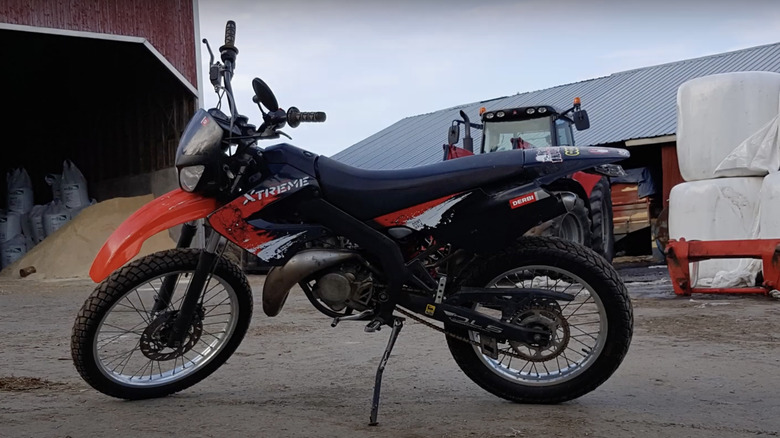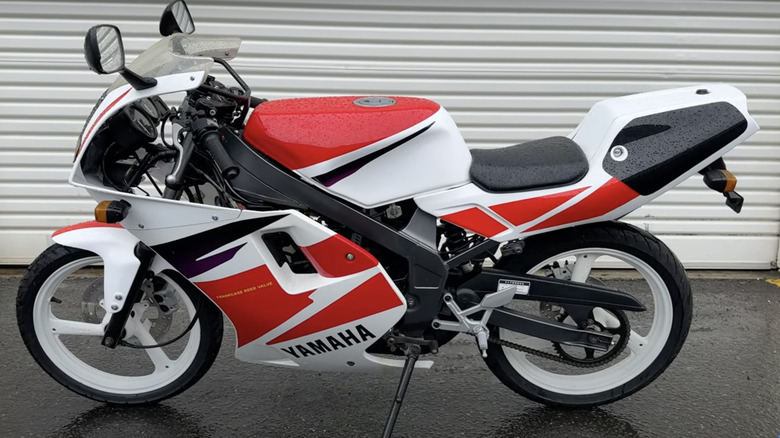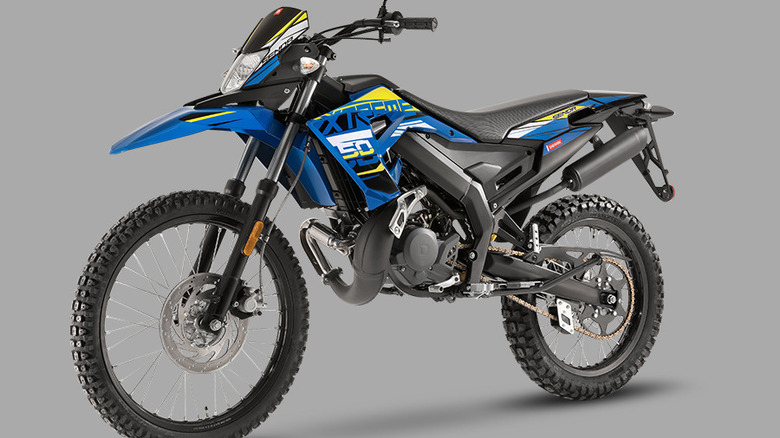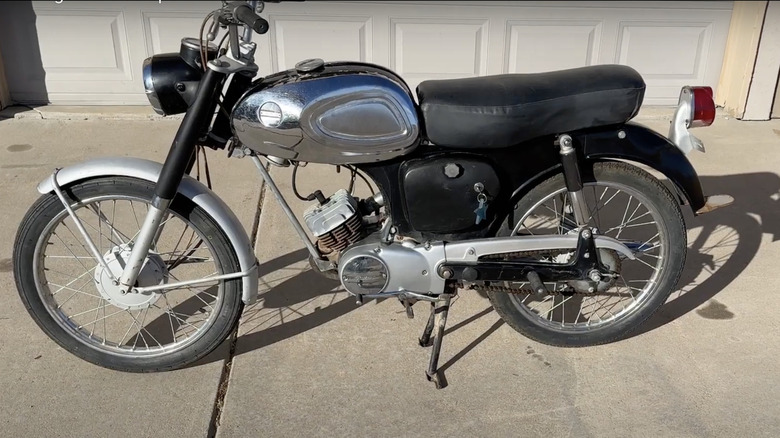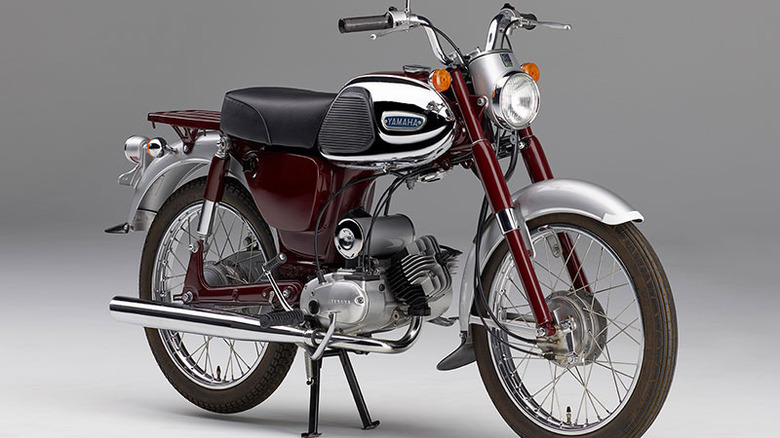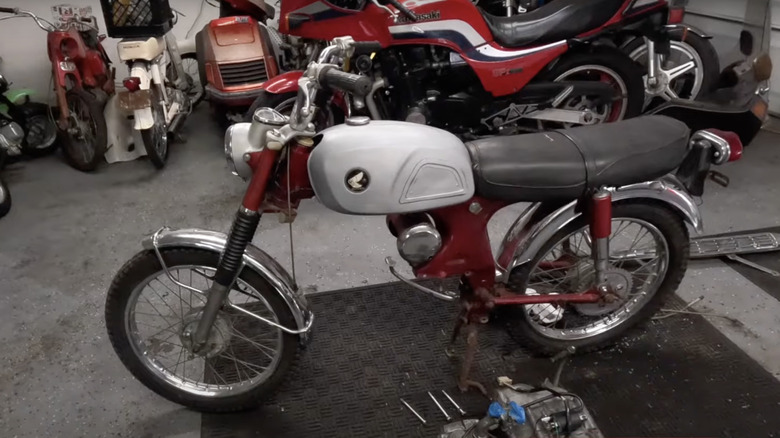5 Of The Smallest Engines Ever Put In A Street Legal Motorcycle
We may receive a commission on purchases made from links.
As the world's streets get more crowded and fuel prices climb, motorcycles remain popular across the globe. Motorcycles Data reported worldwide sales of 62.5 million motorized two-wheeled vehicles last year, with Honda accounting for nearly 30% of those. The popular Japanese brand also landed at the top of our rankings of the world's best motorcycle producers, and the top ten sellers last year were all based in Asia. That left out American icon Harley-Davidson and its stateside rival, Indian Motorcycle, which both rely on large, powerful V-twin engines to move their cruisers. Makers of performance bikes like Ducati, which has a pair of high-speed V2 and V4-powered models in its current line, also land further down the sales list — due in large part to the prohibitive cost of their machines.
For the rest of us, motorcycles with a more reasonable amount of power make for more sensible everyday rides, for the sake of economy and safety. To be honest, most of us can be perfectly happy on a bike that gets exceptional gas mileage and won't roast our thighs with exhaust heat. Here are a few production motorcycles with engines that are big enough to move a rider (and often a passenger) through town safely and comfortably, while all displacing less than 100 cubic centimeters. For the purposes of this list, we're sticking to engines in bikes with traditional motorcycle builds and excluding scooters.
The Yamaha TZR50 could pass for a standard sportsbike
Yamaha is no slouch when it comes to making sport bikes, and the impressive new Yamaha R9 is proof of that. The R9's three-cylinder engine is on the beefier side at 890 cubic centimeters, but around the turn of the century, Yamaha put out a bike with a much smaller engine and classic sportsbike styling. The TZR50 had the aerodynamic fairing, windscreen, and bodywork familiar to sport riders, but its one-cylinder, two-stroke engine displaced just 49 cubic centimeters and produced modest power numbers of 6 horsepower and 2.68 foot-pounds of torque.
Despite the presence of a six-speed transmission, the TZR50 was more impressive to the eye than on the road. It took 23 seconds to cover a quarter mile from a dead stop, and top speed was a neighborhood-friendly 30 miles per hour. The TZR50 was in production from 1998 through 2004, but if you're a taller rider looking for one on the secondhand market, the 32.1-inch seat height might be an issue.
The Derbi Senda is a 50cc dynamo
Derbi motorcycles might not be as common in the United States as American and Japanese-made bikes, but the Spanish manufacturer has a legacy stretching back to the 1920s that includes having a hand in 21 world championships. The Senda 50 has been a part of the Derbi lineup since 1993, and Xtreme, Supermoto, DRD Pro, and Racing submodels were introduced in 2005.
The Senda 50 is currently offered in Xtreme, Racing and Limited Supermoto, and X-Treme 50R Enduro forms, all of which share a 50 cubic centimeter one-cylinder engine that puts out 9 horsepower and 4.4 foot-pounds of torque. That's enough to put a sufficient amount of pep under the sub-200 pound bike. The same engine is used in Derbi's GPR50, a race-inspired bike that served as a learner bike for many European teenagers in the early 2000s. Derbi is now part of the Piaggio Group, which also includes iconic two-wheeler brands Vespa, Aprilia, and Moto Guzzi.
Bridgestone made a 50 cc motorcycle
Bridgestone is known to most people as a maker of tires, but the company was formed as an auto and truck parts manufacturer and has also made golf balls since 1935. For a little over two decades, from just after World War II through the early 1970s, Bridgestone also made motorcycles, like the 50 Sport shown above. The 50 Sport enjoyed a production run of a little over 80,000 units in the mid-'60s, and had a one-cylinder, two-stroke, 48 cubic centimeter engine that produced 4.2 horsepower. That doesn't seem like much when compared to modern bikes, but it was enough to get the 50 Sport up to about 50 miles per hour.
Bridgestone made a handful of other motorcycles with engines ranging in size up to 350 cubic centimeters, but was forced out of the motorcycle making business by other Japanese manufacturers who threatened to stop buying Bridgestone tires. Bridgestone motorcycles are fairly cheap on the secondhand market, although relatively rare. A 1966 50 Sport sold in 2022 for just $351, and two 1969 100 cc models sold at auction in January for $500 and $1,000.
The Yamaha YG-1 had an efficient fuel delivery system
The Yamaha YG-1 is proof that a motorcycle doesn't need a gigantic V-twin engine filling its frame to be objectively gorgeous. This 1960s model had a one-cylinder, two-cycle, 73 cubic centimeter engine that punched well above its modest weight. This was thanks in part to a rotary fuel/oil induction valve system that was primarily used on racing bikes at the time. It allowed for more efficient combustion, providing a sizable punch of 6.6 horsepower and smooth operation. The YG-1's design was classic and clean, with nearly all-metal construction and a carburetor that hid behind a metal cover on the engine's right-hand side.
The 1964 model was released alongside a trail-focused version and sold for under $400 (equal to about ten times that much today), but these bikes are exceptionally hard to find these days. Some diligent internet sleuthing uncovered one that sold in December 2023 for just $1,500, and that lucky Florida buyer took home a very clean specimen in silver and black. Every other YG-1 listing we found was in Europe or Australia and had an asking price of many times that much.
The Honda CL90 was sold in the late '60s
The Honda CL90 was a capable little scrambler with an 89.6 cubic centimeter engine that sent eight horsepower to the rear wheel via a four-speed transmission and chain drive. Honda claimed a top speed of 70 miles per hour, although that figure was hard to reach with a fully-grown adult on board the 202-pound bike. The fuel tank held 1.8 gallons, which Honda claimed was good for over 300 miles of cruising at neighborhood speeds.
The CL90 debuted in 1967 and served as a bridge of sorts between the popular S90 and the SL90 dual-sport model, which was only produced for the 1969 model year. A common frame and drivetrain bound the three 90 cc models together, and the CL90's under-$400 price tag made it accessible to young riders. CL90s are neither plentiful nor particularly expensive today. One sold in 2022 for $3,600, and we found a current eBay listing for a 1967 model in California at $3,500.
